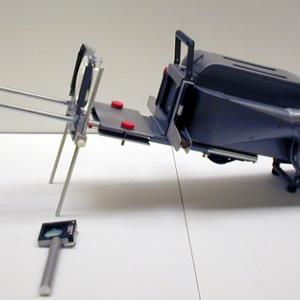College of Liberal Arts & Sciences
5N30.10 - Glass, Water, & CS2 Prisms
There are 2 white light projectors. The one with only one cord is used for this demo. The one with two cords is for the Wien's law demos so that you may vary the light intensity and not ruin the fan motor.
Fill the hollow prism with the desired liquid or the desired combination of liquids. Observe the different amounts of dispersion. Use of carbon disulfide as the liquid is discouraged due to its hazardous environmental properties.
- Christopher J. Olney, "Refractive Index of a Liquid as a Function of Temperature", TPT, Vol. 36, # 1, Jan. 1998, p. 46.
- Jukka O. Mattila, "Spectral Experiments With White Light", TPT, Vol. 32, # 6, Sept. 1994, p. 338.
- Ronald Ebert, "Adapting Some Demonstration for a Large Class", TPT, Vol. 30, p. 239, 1992.
- Donald Olson et al., "Monte Carlo Computer Simulation of a Rainbow", TPT, Vol. 28, # 4, p. 226, April 1990.
- Thomos B. Greenslade, Jr., "Liquid Prism", AJP, Vol. 75, # 1, p. 35, Jan. 2007.
- Oj- 5: Freier and Anderson, A Demonstration Handbook for Physics.
- O-270: "Prisms-Glass & Ethyl Cinnamate", DICK and RAE Physics Demo Notebook.
- George M. Hopkins, "Analysis and Synthesis of Light", Experimental Science, p. 213.
- Julien Clinton Sprott, "6.1, Prism Rainbow", Physics Demonstrations, p. 232, ISBN 0-299-21580-6.
- Andrew Graham, "Index of Refraction of a Liquid", PIRA Newsletter, Vol. 1, # 1, November 1985, p. 4.
- W. Bolton, "The Dispersion Produced by a Prism", Book 2 - Waves and Particles, Physics Experiments and Projects, 1968, p. 41.
- W. Bolton, "Distribution of Energy In a Continuous Spectrum", Book 2 - Waves and Particles, Physics Experiments and Projects, 1968, p. 50-51.
Disclaimer: These demonstrations are provided only for illustrative use by persons affiliated with The University of Iowa and only under the direction of a trained instructor or physicist. The University of Iowa is not responsible for demonstrations performed by those using their own equipment or who choose to use this reference material for their own purpose. The demonstrations included here are within the public domain and can be found in materials contained in libraries, bookstores, and through electronic sources. Performing all or any portion of any of these demonstrations, with or without revisions not depicted here entails inherent risks. These risks include, without limitation, bodily injury (and possibly death), including risks to health that may be temporary or permanent and that may exacerbate a pre-existing medical condition; and property loss or damage. Anyone performing any part of these demonstrations, even with revisions, knowingly and voluntarily assumes all risks associated with them.

